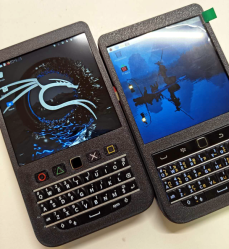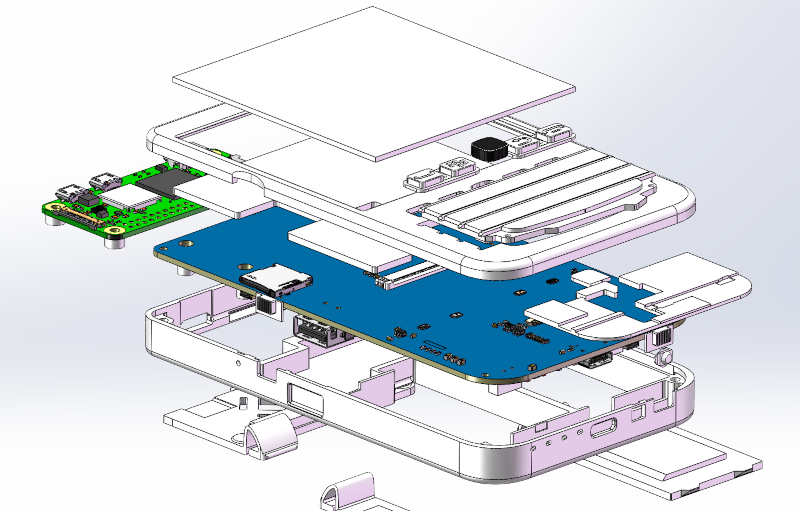There was a time — not so long ago — when a handheld terminal would have been an expensive and exotic piece of kit. Now, all it takes is a Raspberry Pi and an off-the-shelf TFT display, as [ZitaoTech] shows us.

Admittedly, we are now seeing these all over the place, but this build looks well thought out. It looks suspiciously like a Blackberry, which isn’t a bad thing. It also has an interesting dual-battery system that lets you swap between two identical Nokia BL-5C batteries without missing a beat.
The device looks like a Blackberry because it uses the Q10 or Q20 Blackberry keyboard. There is a pass-through switch that lets you use the keyboard and pointer as a USB device on a different host computer.
Rounding out the design are three USB ports, an I2C port, and a TF card slot. Size-wise, the device is about 140 mm tall and 82 mm wide. The thickness is less than 16 mm. Even with the batteries, it weighs a lot less than 200 grams.
In the “Something-you-can-try” directory, there are images for Windows 3.1, mini VMAC, and — of course — DOOM. As you might expect, most of the project is 3D printing the intricate case.
We’ve seen similar projects, including one that has a case inspired by the ZX Spectrum. Then there is Beepy.
















11 being louder than 10 not withstanding, why not just have a larger battery?
From the project description this seems to be why: “Dual Swappable battery Design: Replace your battery in 10 seconds without killing the power!”
Its listed as a feature, so that you can swap the battery without having to power down the device
Its a very handy feature to have if you can’t easily tolerate a restart cycle to change battery.
In the case of one of my old systems it meant with a pocket full of the rather small batteries it uses you can run all day without real interruption – just a little notification that battery 1 is flat and at some point between then and battery 2 going flat you can replace it with one of the battery from your pocket. So yeah not all that impressive now that processors at the low end have so much more efficiency and battery are better, but still never needing to turn it off as long as you have a supply of charged battery available is great..
That said I’m not sure from a quick skim this is that sophisticated, seems like it may be draining both battery while they are both present.
Problem with this design is that batteries are connected ‘in parallel’, without separate charging circuit or switching between batteries. This is pretty bad design. You can check the schematics yourself on github.
(/me is disappointed)
I total agree with you. To make it work correctly their should be 2 ip5306 PBSoC’s used.
BTW : the ip5306 is a nice chip even the price is OK (for me)
What I thought, but I only skimmed the github so I might have missed an important detail somewhere. Still useable if make sure to change a battery before both a drained too much to actually keep the device powered.
After checking the schematic, the batteries are indeed just parallel to each other.
I don’t mind draining both batteries at the same time, as this doubles the runtime before the batteries need attention, but replacing the batteries one by one does not work in this setup.
If you have two almost empty batteries, and you replace one with a freshly charged new battery, then you will get a huge equalization current.
Parallel battery packs have a bad side effect of creating unwanted oscillation. They will never have exactly the same voltage and the lower one will discharge the higher one. Best case they need to be isoated using a low value resistor or ideal diode.
I hate raspberry pi. I need normal handheld with linux. sony, ibm, samsung etc. thin, eficient etc. Why handheld era was done?
On the other hand RPi is over 10 years on market and still you will get updated OS. None of mentioned brands can claim to have one mobile device with such support. Not to mention to have not a single device with so mamy GPIO. Also they have long history of mobile devices with no option to change OS.
I keep seeing projects involving blackberry keyboards, which sounds great, but are these actively manufactured components, or new old stock, or does one have to find a blackberry on ebay, or what?
If there is a standard, usable-ish tiny keyboard that I could plan future projects around, then that’s pretty cool.
Why have two batteries
When you can shove a really large high capacity one
Lifepo4 or li-ion is cheap
Or even nicad
Depends on how much power the chipset need full load vs capacity and battery chemistry
All three have lower internal resistance and can supply very high peak currents with lifepo4 being able to provide peak currents until completely discharged
Well the original ipads used 2 batteries but in parallel as one battery
That was quite bad design. If one battery is weaker it will discharge the other one, and if it fails completely it becomes a load if not a short for the other one, which would make the situation even more dangerous. Lithium batteries can indeed be put in series/parallel, but for real safety they must be individually protected, not just identical but coming from the same lot and used together from the beginning, which makes for example a very very very bad idea to swap only one of them for example.
Do you mean NiMH instead of NiCad? I thought that NiCad was more or less not used anymore in consumer devices. But I’d be interested if there were still use cases and/or benefits to NiCad.
But did you notice its 4 foot display? Very low dpi though :(
because the problem with the sharp zaurus sl5500 is that its power management was too effective so we need to introduce a knock off with less effective power management. hacking to solve the real problems we face
Well if you could still actually get a device like that at all now you wouldn’t have to build something with what is available. Which as far as I know you really can’t, unless it is actually one of the 20 year old models – in which case even if it works electronically it is still about as useful as a brick being without functional battery.
Also comparing something that has less performance than many current watches now from the era before the smartphone craze ruined the market for this sort of device that doesn’t spend all day every day connected to the cellular network with a massively more potent and capable Pi – this thing is still functional in the modern world, can do tasks and access a library of software the old PDA’s couldn’t even dream of…
If you can find a good modern alternative to your Sharp that is actually available for purchase at an at all reasonable price your gripes may have a point. Though even then I’d probably want this more – its a genuine Linux device with the brain being from perhaps the best group ever for supporting their hardware in the kernel. No being stuck on stupendously old Linux kernel full of known faults and manufacturer voodoo to make it work at all…
There are a lot of people who complained dual batteries are not done the right way.
Where could i find docs and schematics to do it right ?
I want to draw power from 3 powerbank 2x10000mah et 1x20000mah and any of them could be replaced on the fly
The big ‘sin’ here that really won’t work well enough to get away with on larger more powerful battery is the complete lack of isolation between each battery. When you put a fully charged battery in it alongside the nearly dead one that has kept the device running the fully charged one will dump as much current as it can handle trying to charge the other battery back up, and on a bigger battery that will mean sparks (heck on a bigger battery that tends to mean sparks even when they are as close to equally charged as you could make them).
If you are using off the shelf powerbanks they will be full of protection circuitry anyway, making just connecting them all together on a common voltage bus probably OK (not that I’d suggest you should, as who knows what is inside that powerbank). Although if any of them have a UPS mode you should be fine to plug one of them into the charge port of the other at least…
Otherwise to do it right you will need a bit of microprocessor brains to really do it with any elegance – in effect you are building your own BMS system and ideally one that can communicate with you or your device – so you can find out which battery is flat etc. As far as I know no off the shelf BMS IC that will just work for you – but it might well exist.
With the only ‘dumb’ but not manually operated route I can think of being to have a binary logic cut off transistor – so while battery 1 is putting out enough voltage the transistors logic gate is active and so cuts off battery 2 and 3 from the device. But that would be seriously dependent on the BMS in the powerbanks- if they never cut off to protect themselves the voltage level keeping that transistor active is probably low enough to over discharge the battery. (also watch out for USB-PD shenanigans)
Unfortunately it uses an unobtanium LCD so you can’t build one yourself.